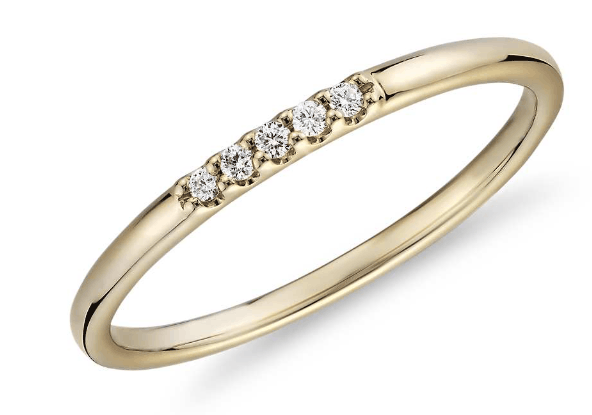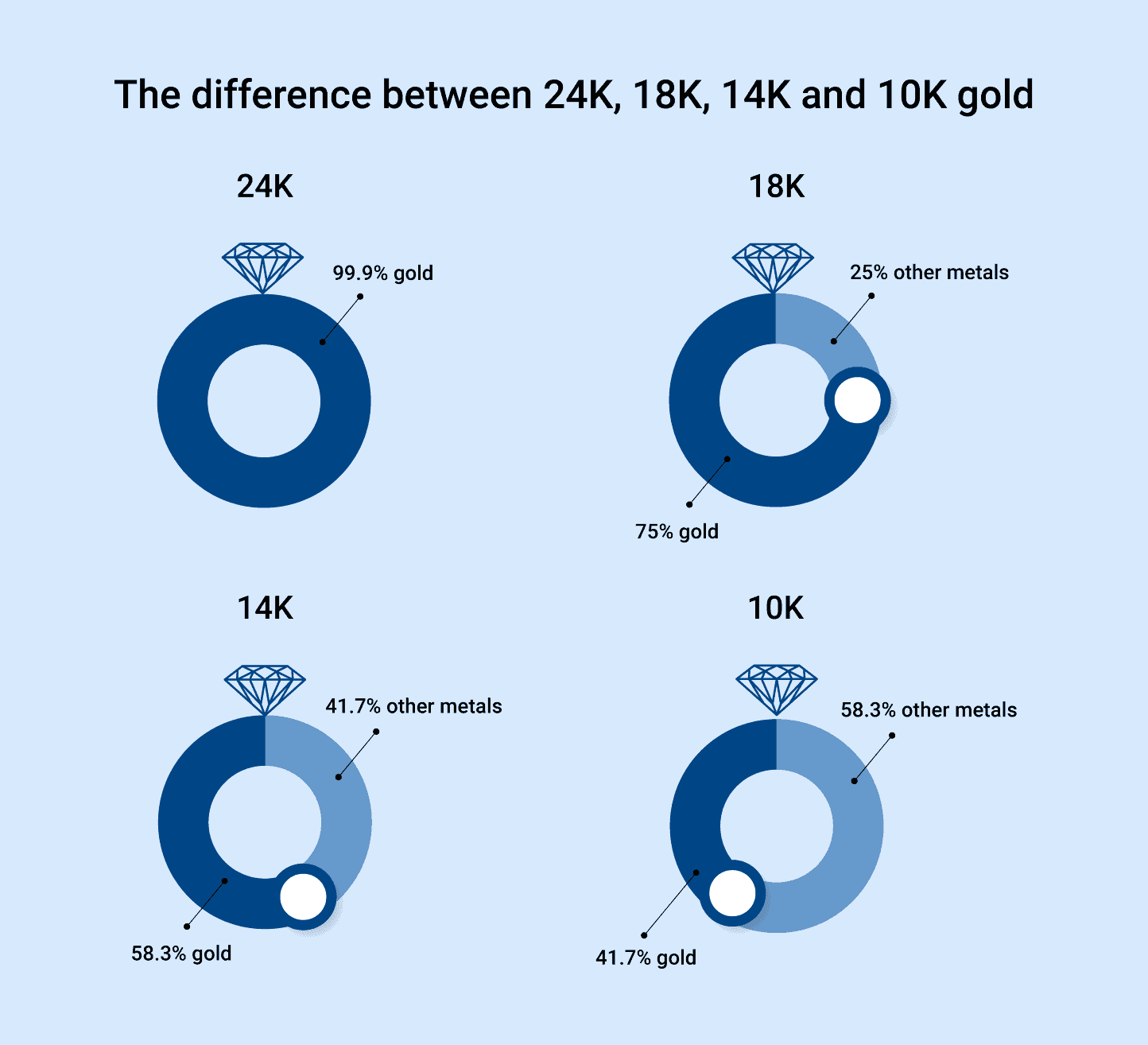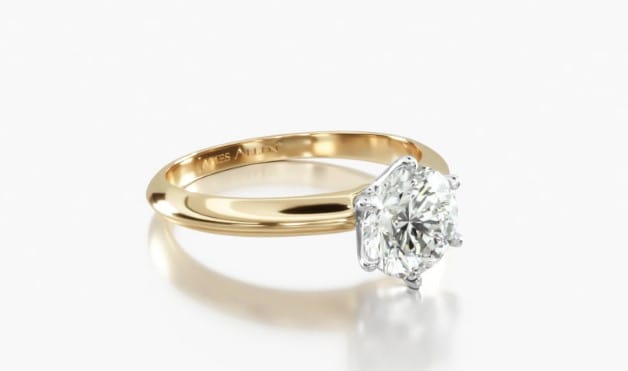A Comparison of 10K, 14K, 18K and 24K Gold
How to choose the best gold for your jewelry
We are reader-supported. Buying through any red colored link on our site may earn us commissions. Learn More.
How to choose the best gold for your jewelry
Gold has been used for centuries and always had a deep meaning. Gold purity is expressed in karats. Pure gold, or 24K gold, is 100% pure. 10K gold, on the other hand, is only 41.7% pure. 14K gold, which is the most popular type of gold for jewelry, is 58.3% pure. Each purity level comes with its own unique set of pros and cons. For example, 24K gold is more valuable and better suited for investment than 14K gold. On the other hand, 10K gold is less expensive but extremely durable and best suited for affordable jewelry-like earrings. 14K gold provides a mix of durability and affordability and accounts for about 90% of engagement and wedding rings sold.
This article will tell you everything you need to know about the different types of gold and what you should be looking for. If you are interested in the best gold type for your engagement, you can skip to that section here.
Gold price calculator
How is gold purity measured?
How many karats is pure gold?
What is 24K gold?
Gold karat scale: What’s the difference between 10K, 14K, 18K and 24K gold?
18K gold: Advantages and disadvantages
14K gold: Advantages and disadvantages
10K gold: Advantages and disadvantages
Which gold is most suitable for engagement rings?
Which type of gold is the best?
FAQs
Why you should trust us
Knowing what each karat type means and how that affects the price is crucial when purchasing gold jewelry. Take a look at this stunning 14K gold paper clip bracelet from James Allen and compare it to this gorgeous 18K gold link chain bracelet from Amazon. Why is the one from Amazon more expensive? Is it because of the weight? Possibly, but the main reason it’s more expensive is that it has a higher quality gold.

Are you looking to sell your gold? This article is geared towards helping people looking to purchase jewelry. If you are looking to sell your gold, feel free to hop on over to our Selling Your Jewelry page. If you are looking to sell your diamond engagement ring, we have a specific article for Selling Your Diamond Ring
This email will go to our contact at Abe Mor who has helped thousands of our readers sell their gold and diamond jewelry. They consistently offer the highest prices for our readers' jewelry. Please include the weights and details of the jewelry. Images are helpful as well.
$0
ValueThis is the current wholesale price of gold. When selling gold you receive a percentage of the price. We recommend asking Abe Mor for a quote as they have consistently offered the highest percentage to our readers.
Get an Offer24K gold is pure gold. Since it’s very soft and malleable, this type of gold isn’t used for engagement rings.
While gold purity levels can seem a little confusing at first, they’re fairly easy to understand once you’re familiar with the basics. Below, we’ll walk you through:
We’ll also look at the impact gold purity can have on the cost of your engagement ring (or other jewelry) to help you use your budget as effectively as possible.
You can go through recently purchased diamond engagement rings from our top-rated retailers for inspiration:



The purity of gold is categorized using the karat scale. The karat scale measures the ratio of pure gold to other alloys in a piece of gold jewelry. The greater the amount of pure gold in a gold ring or other piece of jewelry, the higher the purity level.
Pure gold is 24 karat, meaning that 24 out of 24 parts of the metal are gold. Although the terms sound familiar, the karat (K) scale used to measure the purity of gold is different from the carat (c) unit of mass that’s used to weigh diamonds.

Contrary to popular belief, when you purchase a gold engagement ring or other type of jewelry, the metal used for the jewelry probably isn’t 100% gold.
Pure gold, or 24K gold, is gold that hasn’t been mixed with any other metals. 24K gold isn’t used for jewelry for several reasons:
Because of these factors, it’s very uncommon for 24K gold to be used in engagement rings and other types of wearable jewelry in the United States and other Western countries.
Instead, 24K gold tends to be more popular in China and other Eastern markets, where it’s used in traditional Chinese wedding jewelry such as bangles, in gold bars, and as a material for other collectible items.
Gold purity content is categorized using the karat scale. Depending on the ratio of pure gold to other alloys, the gold used in engagement rings and other jewelry is usually categorized as 10K, 14K, 18K, 22K and 24K.
| Karats | Parts of Gold | Purity [%] | Millesimal Fineness |
|---|---|---|---|
| 24K | 24/24 | 99.9 | 999 |
| 22K | 22/24 | 91.7 | 916/917 |
| 18K | 18/24 | 75 | 750 |
| 14K | 14/24 | 58.3 | 583/585 |
| 12K | 12/24 | 50 | 500 |
| 10K | 10/24 | 41.7 | 416/417 |
| 9K | 9/24 | 37.5 | 375 |
Each type of gold has a different purity level. Pure gold, or 24K gold, is 100% pure. 10K gold, on the other hand, is only 41.7% pure. 14K gold, which is the most popular type of gold for jewelry, is 58.3% pure.
There’s no “best” type of gold for every application. Instead, each purity level has its own range of advantages and disadvantages. We’ve covered these below:
18 karat gold is made up of 75% gold and 25% alloy. This type of gold is referred to as 18 karat because 18 out of the 24 parts that make up the gold are pure gold. 18K gold is usually the purest form of gold used for rings, watches, and other wearable jewelry.
18K gold has a rich, yellow appearance that makes it an attractive material for engagement rings and other jewelry. Since 18K gold is almost pure, there’s very little risk of jewelry made using this material causing any skin irritation if you have a nickel allergy.
In short, 18K gold looks fantastic, with the classic yellow appearance that most people associate with gold jewelry.
This stunning hand-engraved solitaire engagement ring from Blue Nile is great example of the warm tone of 18K gold.

However, 18K gold also has several disadvantages. First, since it’s quite pure, it’s fairly easy to scratch jewelry made using 18K gold. If you’re active or work in a setting where your ring might bump into hard surfaces, 18K gold might not be the best choice.
18K gold is also significantly more expensive than other types of gold. Compared to a 14K gold ring (read our 14K vs. 18K comparison), which looks similar but not quite as bright or saturated, you’ll usually need to pay upwards of twice as much for an 18K ring.
All in all, 18K gold is a good choice if you want gold jewelry that’s as pure as possible while still offering some practicality. However, it’s not the best option if you need a ring that’s very durable, or if you’re on a limited budget.
14 karat gold is made up of 58.3% gold and 41.7% alloy, or 14 out of 24 parts gold. 14K gold is the most popular gold for rings and other wearable jewelry in the United States, the UK and other Western countries.
About 90% of all engagement and wedding rings are made from 14K gold, making this a good go-to choice if you’re not sure which type of gold is best for your purchase.
14K gold has a rich color, with the classic gold appearance that most customers look for in rings and other jewelry. Its color is slightly less saturated and intense than 18 karat gold, making it an excellent choice if you want gold jewelry that’s rich and attractive but not overly yellow, like this 14K yellow gold petite tapered pavé engagement ring from James Allen.
Compared to 18K gold, the main advantages of 14K gold are its durability and affordability. Rings and other jewelry made using 14K gold are significantly more durable than those made with 18K gold, making this type of gold a good choice if you’re concerned about scuffs and scratches.
This 14K yellow gold pavé engagement ring from James Allen and this gorgeous petite diamond engagement ring from Blue Nile both have the classic 14K look, with a rich gold color that’s slightly less saturated than equivalent 18K settings.

14K gold is also more affordable than 18K, making it a good all-round option if you’re looking for a mix of quality, durability, and value for money.
The only real downside of 14K gold is its potential to trigger skin irritation. Because 14K gold has a higher alloy content than 18K gold, it can occasionally result in itchy, uncomfortable skin if you have a copper, silver, nickel, zinc, or iron allergy.
10 karat gold is made up of 41.7% gold and 58.3% alloy, or 10 out of 24 parts gold. 10K gold is the least pure, least expensive and most durable form of gold used in jewelry. It’s also the most impure gold can be while remaining legally “gold” in the US and most other countries.
Although it’s widely used in earrings and affordable jewelry, 10K gold isn’t a very popular metal for engagement rings and fine jewelry. Many high-end, luxury jewelry retailers don’t even offer 10K gold pieces due to its relatively low gold content.
Aesthetically, 10K gold has a pale appearance, with a significantly less rich yellow tone than 14K or 18K gold. Its pale color is something you either like or don’t — some people like it for its visual subtlety, while others prefer the rich gold tone of 14K and 18K gold jewelry.
The biggest advantages of 10K gold are its cost and durability. 10K gold is the cheapest type of gold available in the US, making it a good option if you’re shopping for a ring or other jewelry on a tight budget.
Since it has the lowest gold content of any type of gold, 10K gold is also highly durable. It’s very difficult to scratch, scuff, or bend jewelry made from 10K gold, making it worth considering if you work in an environment with hard surfaces that could scratch or damage your jewelry.
The main disadvantage of 10K gold is its risk of causing skin irritation if you’re allergic to certain metals. If you’re allergic to copper, silver, nickel, zinc, or iron, it’s possible for your skin to break out with allergic contact dermatitis if you wear a 10K gold ring for a long period of time.
Shopping for an engagement ring? There’s more to picking the perfect ring than just choosing the right diamond and setting. The type of gold used in an engagement ring can have a huge impact on its appearance, feel, and durability. We recently helped two readers find rose gold engagement rings. One reader went with this bold 14K setting from James Allen while the other went with this, subtler, 14K setting from Blue Nile.
Most importantly, making the right choice can help you get the best bang for your buck overall. Take this ring from James Allen for example. Depending on which metal you choose, the price difference is $200. That means you can get this diamond or if you end up with the 14K version of this ring, you can get this diamond which is 25% larger while spending the same amount of money.
Contrary to popular belief, there’s no single type of gold used for all gold jewelry. The gold used for rings, bracelets, watches and other fine jewelry is rarely 100% pure gold — instead, it comes in a variety of different purity levels.
The most common gold purity levels are 10K (karat), 14K, 18K and 24K. Each level of gold purity offers its own range of advantages and disadvantages, from hardness and durability to the risk of certain levels of gold purity contributing to skin irritation.
Of the four most common gold purity levels:
According to JCK, an industry insider publication, the FTC has weakened regulations. You are now allowed to call something gold as long as it contains 1 kt worth of gold. This is nothing more than a way to market something as gold while being significantly cheaper. We would not recommend pursuing this option.
There’s no “best’ type of gold for everyone. When you’re choosing the gold for an engagement ring or other jewelry, it’s important to keep factors such as your or your partner’s skin sensitivity, career, activity level, and aesthetic taste in mind.
It’s also important to shop with your budget in mind. While an 18K ring might look fantastic, it’s almost always going to cost significantly more than a similar option in 14K or 10K gold.
Most of the time, 14 karat gold provides the best combination of rich color, good durability and reasonable affordability. This type of gold is by far the most popular option for engagement rings and other fine jewelry, making up about 90% of gold jewelry sales in the United States.
If you prefer something more luxurious and don’t mind trading some durability for a richer gold color, 18 karat gold can be a good choice. Just be aware that this type of gold is quite soft and could scratch easily while you or your partner work or exercise.
Tallulah Willis, daughter of Bruce Willis and Demi Moore got her engagement ring in yellow gold and it looks spectacular.
Most of the time, 10 karat gold isn’t used for engagement rings. Because the difference in price between 14K and 10K gold is so negligible, the vast majority of reputable jewelers will offer 14K as their most affordable option for engagement rings.
If you see a 10 karat gold engagement ring, it’s often a good indicator that the diamond or another gemstone probably isn’t up to the standards you’d want.
Shop for diamond engagement rings here.
Need help choosing the right engagement ring? Send a message to our experts and we’ll get in touch with personalized advice on the highest-quality options for your budget.
18K gold is the highest-quality gold, between 10K, 14K and 18K. It has the highest purity and the most attractive appearance. However, there are advantages to lower-karat golds too. They’re more affordable, and more importantly, more durable, making them better for active, practical use.
10K gold through to 24K gold all have their advantages. 24K is more valuable, and better as a store of value or investment, while 10K gold is more durable and better for practical use. 14K and 18K gold are in the middle, and generally best for jewelry.
White gold does retain some resale value. You won’t get near the same amount you originally paid, but it’s not worthless. The issue is that it’s not pure gold, it’s mixed with alloys that give it the white color. However, white gold and yellow gold of the same karat should have a relatively similar resale value (albeit 50 cents on the dollar).
If you’re looking to sell your jewelry, check out our selling gold article.
14K gold is generally the best for jewelry. It’s in the sweet spot for durability, attractiveness and affordability. If you want to sacrifice some durability for a richer color, you can opt for 18K instead.




Before you buy a diamond, get personal buying advice from industry veterans. We'll help you get the best diamond for the money.
DISCLAIMER: We don't use your email for marketing. Period.
A diamonds’ price is determined primarily by the 4 Cs of the diamond. On the wholesale level, diamond prices are first based on a diamond shape and
Buying an engagement ring is often one of the first major purchases in a person's life. The process can be fraught with tension as there are so m
A wide range of 1 carat diamonds exist both in online markets and local diamond jewelry stores. Not only are there significant differences in beauty
Please enter your email address to receive your 25% off coupon code:
Here is your coupon code: GFDSF3GF